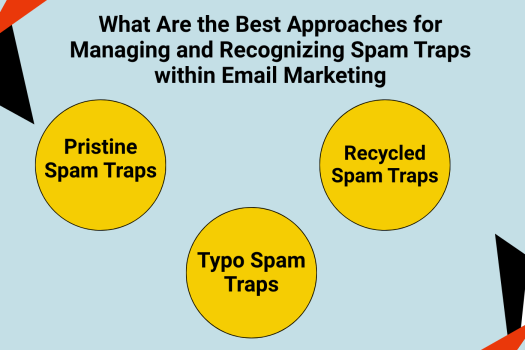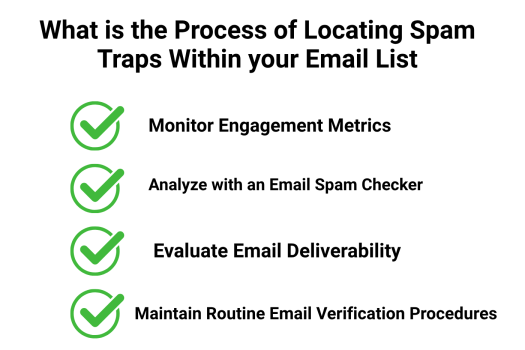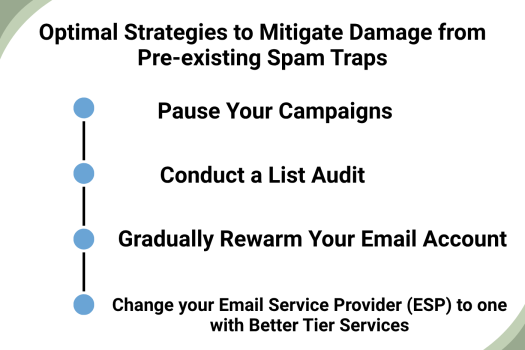BLOG'S
Table of Contents
Published on: June 02, 2025 05:11 PM
How to handle and identify
spam traps in Email Marketing
Email marketing helps in reaching and engaging the
audience systematically. Regardless of the skill put in an email campaign, if the message gets labeled as spam, it will always
fail. Having spam traps in your list
is one of the biggest risks when it comes to email deliverability.
In this article we explain what spam traps are and how to identify
them. We also explain their relevance for your business email marketing services and most importantly, what can be done to
improve email deliverability and inbox
placement.
Spam Traps: Definition and
Examples
In the case of spambots, some developed email addresses that exist purely and
uniquely for identifying and capturing them. Spam traps might seem ordinary at
first glance, so it is easy to confuse them with active accounts which belong
to real customers. However, spam trap
accounts don’t receive every other email sent to them. They work under very
specific guidelines which, if not followed, would result in your message being labeled
as spam and account being flagged
when interacted with.
What are the Best Approaches for Managing and Recognizing Spam Traps within Email marketing?
Like mentioned before, spam traps can be classified into different categories based on
their structure. The three most common of these are:

1. Pristine
Spam Traps: These are the most basic spam traps that every email marketer
should be aware of. These addresses are untouched and never used for anything.
2. Recycled
Spam Traps: Inactive and obsolete email
accounts that were once used and are now restored by ISPs to scan for
unwanted emails.
3. Typo
Spam Traps: These are triggered by the frequent use of “gmial.com” instead of “gmail.com” and aim to target poor list
oversight or unintentional inclusions.
Why Are Spam Traps
Dangerous?
Getting trapped in a spam filter can have
damaging consequences risks:
·
Compromised
spam filter avoidance measures
·
Permanently
blacklisting by admins
·
Ceasing
operations associated with Email marketing systems
·
Have
reputation as a sender tarnished
·
Spend
expensive marketing cost
Whether you choose to not send spam mails, hitting a trap indicates
poor list grooming that can impact your email campaigns adversely.
What is the Process of Locating Spam Traps Within your Email List?

Locating spam
traps is not easy, but here are some simple steps that can help you
eliminate them.
1. Monitor Engagement
Metrics
A spam
trap does not interact with the content. You should pay attention to email addresses that:
·
Do
not open your emails
·
Do
not click any links
·
Always
bounce.
A cluster of unresponsive email accounts can be spam
traps.
2. Analyze with an Email
Spam Checker
An email
spam checker or email spam test
tool evaluates your email lists and
campaigns for emerging suspicious email
addresses and checks for compliance with authentication protocols.
3. Evaluate Email
Deliverability
Conduct an email
deliverability test before the launch of any email campaigns. These tools flag poor domain reputation, spam
signals and other issues tied to spam
traps as diagnostic problems.
4. Maintain Routine Email
Verification Procedures
Email verification is important. Maintain your email list through periodic checks with
reliable aids, eliminating:
·
Invalid
or misspelled email addresses.
·
Inactive
or non-existent accounts.
·
Known
trap domains.
How to Prevent Spam Traps in Email Marketing?
Having understood the adverse effects of spam traps, consider the strategies
that can assist in their avoidance as you work on increasing your email deliverability.
1. Opt-in Driven
Permission-Based Lists Construction
An email
list should never be bought or rented as they include spam traps and low quality leads. Capture willing customers through
forms where users voluntarily provide their email addresses.
2. Implement Double Opt-In
Process
This approach verifies a subscriber's goal and
for your website subscriptions, when users provide their Gmail accounts or emails,
ensure you send a confirmation message as the final step for them to confirm
the subscription, this guarantees:
·
Email
accounts are active
·
Better
engagement metrics
·
Reduced
Spam Trap issues
3. Perform Regular Email
List Cleanup
Prioritize hygiene via list cleanups done on a
routine basis to remove:
·
Users
who are inactive (3-6 months no open/click activity)
·
Hard
Bounce users
·
Potential
spam email accounts
Professional email verification systems can help automate this process.
4. Data Customization and
Email Personalization
Targeting narrower user segments leads to fewer
complaints while increasing engagement. A relevant email campaign will shield
you against negative impacts from spam trap issues.
5. Steer Clear from Spam
Trigger Words
Commonly used spam phrases prevent systems from
sending junk emails, as will the use of CAPS in subject lines.
Pre-send spam
email checker analyzes the content and subject lines to ensure everything
is within specs before sending them out.
Optimal Strategies to
Mitigate Damage from Pre-existing Spam Traps

If you’ve encountered spam traps, it does not
mean all hope is lost. Here are the suggested steps to take:
1. Pause Your Campaigns
Immediately halt all email sends. Resolving the
issue identified within your recent campaigns will stop further damage to your
reputation.
2. Conduct a List Audit
Collaboratively, algorithms and users can scan
your email list:
·
Cross-reference
against trap domain databases
·
Identify
and remove disengaged users
·
Conduct
email verification tests
3. Gradually Rewarm Your
Email Account
If issues with email deliverability arise,
begin warming up:
·
Start
with a small group of active users.
·
Gradually
increase the volume.
·
Monitor
engagement and reputation.
·
This
improves reputation with ISPs.
4. Change your Email
Service Provider (ESP) to one with Better Tier Services
Consider switching if your current ESP does not
offer proper list hygiene tools or filters. Top-tier email services provide
real-time bounce handling, feedback loops and advanced spam email filtering.
Tools to Avoid Spam Traps
Your efforts in email marketing can be protected from spam traps with the following tools:
·
ZeroBounce: Especially good with email verification and detection of
traps.
·
Mail Tester: Performs exhaustive email spam tests.
·
SendForensics: Assesses and tracks the email deliverability metrics.
·
MXToolbox: Great for conducted blacklist
checks and diagnosing email spam filters.
Avoiding Spam Filters with
Email Marketing Strategies
Achieving goals with sophisticated techniques
as well as the right tools will ensure that your email marketing services are effective, as well as email deliverability rates are
maintained high. Here are some timeless evergreen email marketing best practices:
- Solicitation to an email list should be verification-based, opt-in only
- Utilize clear call-to-action buttons to unsubscribe.
- Adhere to a fixed sending cadence.
- Customize subject lines and contents to the user.
- Conduct periodic A/B testing.
- Focus on track, bounce and complaint rates.
Eliminating Spam Emails While
Improving Brand Trust
Strange as it may sound, in attempting to stop spam emails, marketers can end up
being labeled spammers themselves. Here’s how to navigate such a gray area
carefully:
- Keep user-facing data collection reasons as clear as possible.
- Emails issued should include the companies registered details with email “from” address, as well as privacy in the footer.
- Guide subscribers on safe email dealings.
In addition, make sure that your email address is authenticated through
SPF, DKIM and DMARC records.
Conclusion
Staying clear of spam traps is more than just preserving the dignity of your email account or Gmail email; it's about maximizing ROI and value for your audience.
If you maintain clean lists, employ proper email
verification, use smart tools such as an email spam checker and follow email
marketing best practices, your campaigns can be poised for success without
the looming threat of spam emails or
deliverability challenges.